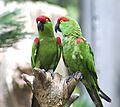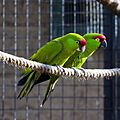Thick-billed parrot facts for kids
Quick facts for kids Thick-billed parrot |
|
|---|---|
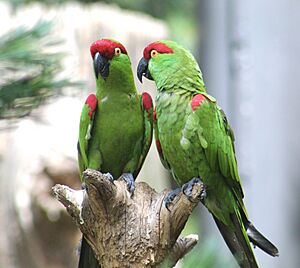 |
|
| Thick-billed parrots in a U.S. zoo | |
| Conservation status | |
| Scientific classification | |
| Genus: |
Rhynchopsitta
|
| Species: |
pachyrhyncha
|
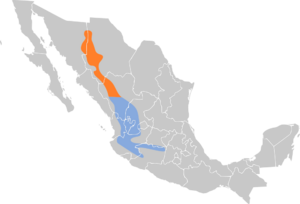 |
|
| Synonyms | |
|
Macrocercus pachyrhynchus |
|
The thick-billed parrot (Rhynchopsitta pachyrhyncha) is a medium-sized parrot that lives only in Mexico. It used to live in the southwestern United States too. People sometimes call it a thick-billed macaw or thick-billed conure. In Mexico, it's known as guacamaya (macaw) or cotorra serrana (mountain parrot). This parrot is an endangered species, meaning it's at risk of disappearing forever. In 2018, scientists estimated there were about 1,700 thick-billed parrots left in the wild in Mexico.
Contents
What is a Thick-Billed Parrot?
The thick-billed parrot is a bright green bird with a big black beak. It has red on its forehead, shoulders, and upper legs. Adult parrots have amber (yellow-orange) eyes, while young parrots have brown eyes. The rest of its body is a vibrant green. When it flies, you can see red on its shoulders and the front edge of its underwing. This is followed by a dark green stripe, then a yellow stripe, and the rest of thewing is dark green. Its tail is black.
This parrot is about 38 centimeters (15 inches) long. It weighs between 315 and 370 grams (about 0.7 to 0.8 pounds). Thick-billed parrots have lived for up to 33 years when cared for by humans. It looks a bit like the military macaw or the lilac-crowned amazon, but these are not its closest relatives.
How Does This Parrot Sound and Act?
The thick-billed parrot's voice sounds like a high-pitched macaw. It makes many loud, rolling calls that some people say sound like human laughter. Even though they can become friendly with people, these parrots are shy and hard to breed in zoos. They don't have many babies when kept in captivity.
Parrots in captivity can learn to copy a few words or phrases. However, their loud calls and less colorful feathers mean they are not very popular as pets. There isn't much demand for them in the pet trade, whether caught from the wild or bred in captivity.
Like other parrots, they use one foot to hold their food. They are very social birds and often feed each other food from a pouch in their throat called a crop. They also spend time grooming each other's feathers. In the past, groups of over 1,000 thick-billed parrots were seen together.
Where Do Thick-Billed Parrots Live?
The thick-billed parrot lives in cool forests with conifer trees like pine and fir. These forests are found at high elevations, from 1,200 to 3,600 meters (about 3,900 to 11,800 feet) above sea level. Today, they mostly live in the Sierra Madre Occidental mountains in the Mexican states of Chihuahua and Durango.
Former Range in the United States
In the past, their home included parts of the United States, such as Arizona and New Mexico. Some old records even say they were seen in far west Texas, and possibly as far north as Utah. People reported that the birds visited Arizona and New Mexico regularly, and even stayed there during winter.
However, during these times, many parrots were shot, and their forests were cut down. This led to the thick-billed parrot disappearing from its U.S. range. The Carolina parakeet, another native U.S. parrot, also became extinct. Now, the green parakeet is the only native parrot species left in the United States. The last reliable sightings of thick-billed parrots in the southwestern U.S. were in Arizona in 1935 and 1938.
What Do Thick-Billed Parrots Eat and How Do They Live?
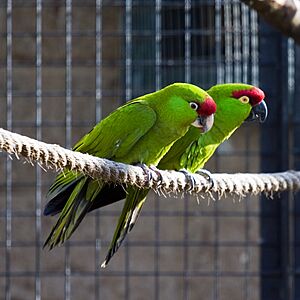
Like most parrots, thick-billed parrots build their nests in holes in trees. They especially like old holes made by woodpeckers. In the past, they probably used many nesting holes made by the imperial woodpecker, which was the world's largest woodpecker. The disappearance of the imperial woodpecker might have contributed to the parrot's decline. In some areas today, they prefer to nest in dead or living quaking aspen trees.
What Do They Eat?
These parrots mainly eat seeds from different types of pine trees. They seem to prefer Mexican white pine seeds. They also eat seeds from Douglas fir, Apache pine, Chihuahua pine, and yellow pine. The parrots depend a lot on the supply of conifer cones. They breed when pine seed production is at its highest. They are nomadic, meaning they move around to find places with lots of cones. They also eat acorns and pine buds, but less often.
Thick-billed parrots are excellent fliers. Old stories describe them sleeping in one mountain range and flying long distances to another mountain range every day to find food. They can even deal with deep snow by hanging upside-down and climbing on the bare underside of snowy branches to reach cones.
Why Are Thick-Billed Parrots Endangered?
The main dangers to the thick-billed parrot are:
- Illegal pet trade: People illegally catch them to sell as pets.
- Habitat loss: Their forest homes are being destroyed, mainly due to logging (cutting down trees).
- Climate change: Hotter temperatures raise the snow line and increase the risk of forest fires.
- Predators: Hawks and owls hunt them.
Because of these threats, the thick-billed parrot is listed as endangered on the IUCN Red List of Threatened Species. It's also on Appendix I of CITES, which means it's illegal to trade them internationally for money. The U.S. Fish and Wildlife Service also lists it as endangered.
Efforts to Reintroduce Them in Arizona

In the 1980s, people tried to bring thick-billed parrots back to Arizona. However, this effort was not successful. Many of the reintroduced birds were eaten by predators, especially goshawks. There were many predators because of human development and farming in the area. The reintroduction effort stopped in 1993, and the last of these parrots was seen in 1995.
Some parts of the project, like keeping birds in small cages for a long time before release, might have made it harder for them to survive. Modern ways of releasing captive birds are different. They don't keep adult animals in cages for long periods before letting them go.
In October 2020, researchers in Arizona announced plans to try again to reintroduce the thick-billed parrot to the state. They are working with officials in Mexico. They believe the birds prefer high-elevation forests, like those in the Chiricahua Mountains.
Thick-Billed Parrots and Native Americans
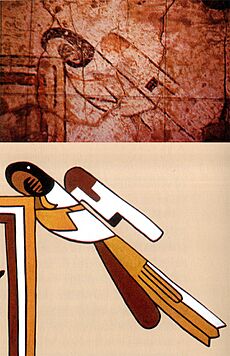
Scientists have found bones of thick-billed parrots in ancient Native American towns in the American Southwest. These bones were used in religious burials. They also found sacred and decorative images of these parrots painted on pottery. These sites are far north of where thick-billed parrots live today in Mexico.
Some sites include Wupatki Pueblo in Arizona and Chaco Canyon in New Mexico. A thick-billed parrot feather was even found in Colorado, used in a medicine man's special object. This shows that either feathers were traded, or the parrots traveled very far north. Since there's no proof that live birds were traded, but live parrots were used in burials, it's possible that thick-billed parrots once lived further north or traveled there.
One of the most famous images of a thick-billed parrot comes from the Pottery Mound site in New Mexico. This site has pictures of the three parrot species most often used in religious ways in the American Southwest: the scarlet macaw, military macaw, and thick-billed parrot. The painted bird is identified as a thick-billed parrot because it doesn't have the bare skin around its eyes that macaws do.
Images for kids



